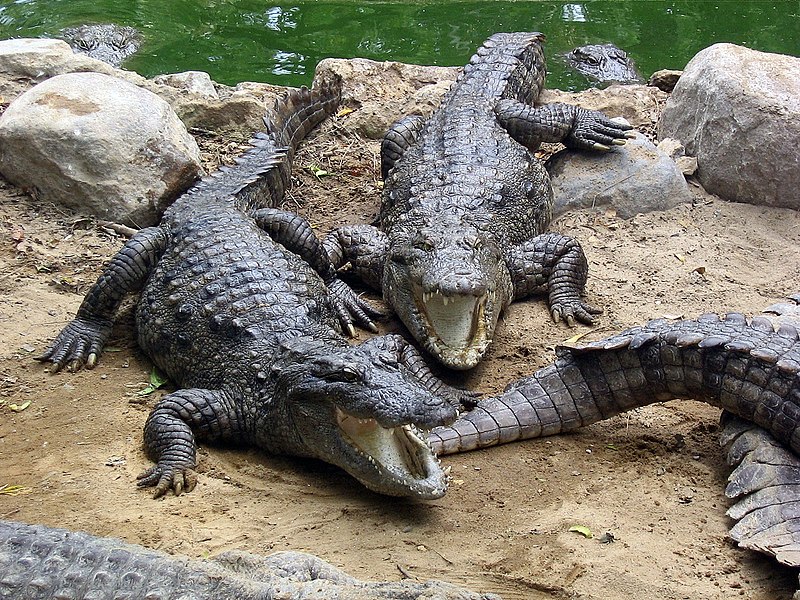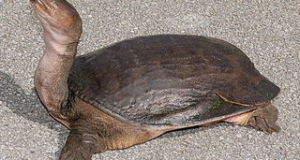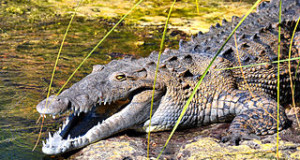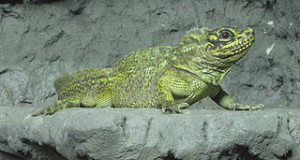
Natural History
Marsh Crocodiles are aptly named – despite being powerful swimmers, they favor the calm, plant-choked waters of swamps and marshes over swift-moving rivers (the species name, “palustris”, is a reference to their habitat).
Their range extends from Bangladesh, Nepal and Pakistan through India and Sri Lanka.
A Surprise
A single population of Muggars holds on in a country not known for its crocodiles, Iran. The Iranian Muggars live in the southeastern part of the country, which is the species western-most limit. The most recent survey of this group documented 150 individuals, but estimates put the total population at 300 or so.
Dammed river sections and village ponds account for an important part of this population’s habitat – one large reservoir is even protected as a breeding site. Muggars spend periods of cold and hot weather in long, self-dug burrows, and fishes form the bulk of their diet. Water birds, snakes and other animals are taken opportunistically.
Fortunately, Muggars are not hunted in Iran and are reportedly viewed as culturally important animals. They are protected as an endangered species and a national management plan, containing research, educational, captive breeding and ecotourism components, is in place.
Muggars at the Zoo – A Vexing Problem
While working at the Bronx Zoo, I cared for a group of these most fascinating reptiles but unfortunately the exhibit was not conducive to breeding.
Sadly, a number of visitors tossed coins into the crocodiles’ open mouths (crocodiles cool off by lying with their jaws open, in order to expose the blood vessel-laden tongue to the air) and over the years the animals were slowly poisoned by zinc and other metals as the coins were digested. We lost several animals, but others recovered and were re-located to zoos with covered exhibits (or better-behaved visitors!).
Further Reading
IUCN Report on Marsh Crocodile populations, natural history and conservation recommendations.
Check out the size of the Marsh Crocodiles in this video – easy to see why reintroductions must be carefully planned so that crocs and people do not meet up!
Please write in with your questions and comments.
Thanks, until next time,
Frank Indiviglio
Basking Muggars image referenced from wikipedia and originally posted by Kminoj
Marsh Crocodile image referenced from wikipedia and originally posted by Hericks
 That Reptile Blog – Reptile, Amphibian and Exotic Pet Care and Information
That Reptile Blog – Reptile, Amphibian and Exotic Pet Care and Information





hey i am a 8th grade student who is hoping to be a herpetologist so any help i will take
Hello, Frank Indiviglio here.
Thanks for your interest in our blog; great to hear you are planning ahead – very wise.
At your age, one of the best practical steps you can take is to volunteer at a local nature center, zoo or museum – even if not directly herp related, this will put you in touch with people in the field and show you are serious about your interests (keep in mind, so many people have fleeting interests these days; herpetologists tend to help out those who are serious about a career). Join local herp societies, and sign up for any special programs that a local museum or zoo may offer (teen internships, lectures on herps, etc).
Spend time reading books and, if possible, professional journals – again this will distinguish you from the millions who just pick and choose from the net (much of value is there, of course, also). Professional journals (Copeia, Herpetologica, Herpetological review) are expensive, but Herpetological Cons and Biology is free and available on line. The IRCF journal is very reasonably priced. These journals will show you what people are doing in the field today; The Center for NA Herpetology also posts internships, highlights new research, etc and has an article on how to become a herpetologist – very valuable and free online.
Education is vital for any position from zookeeper to researcher or curator. Please check my article on Steps to Becoming a Herpetologist; Part II will be posted soon and Professional Herpetological Organizations.
Think about the above an d please write back with specific questions – it’s not an easy road, but very, very worthwhile if it is your passion.
Good luck, enjoy and please keep me posted.
Best regards, Frank Indiviglio.
“Sadly, a number of visitors tossed coins into the crocodiles’ open mouths…”. Oh my, one of those things that zookeepers have to deal with that zoologists out in the field probably never even imagining. Such a visual, and sad image!
Hello Brett, Frank Indiviglio here.
Nice to hear from you again. Yes, they face troubles in the wild and captivity! I have to say that visitor behavior has improved in recent years, but zookeepres and security people still have their hands full.
Best regards, Frank Indiviglio.
Hello Frank,
Reminds me of how the sole Rafetus swinhoei was reported to be eating junk food and plastic trash thrown into its pond by visitors. Not much concern apparently for the last hope for this species. Hopefully they lay eggs again this year and that they produce lots of healthy hatchlings!
~Joseph
Hello Joseph, Frank Indiviglio here.
Nice to hear from you as always, thanks.
Yes, the story of Southeast Asia’s giant softshelled turtle, which may be down to 2-3 individuals, is quite interesting and sad. Peter Pritchard’s classic Turtles of the World details the story, which the author first publicized many years ago (great book if you are interested in personal observations and such, as well as pure science; he highlights several other softshells there also, including a species that may be limited to a single temple pond in India). Dr. Pritchard has often spoken at meetings of the NY Turtle and Tortoise Society, and keeps us posted on breeding efforts; I’ll write an update at some point, thanks for reminding me.
Good luck and enjoy,
Best regards, Frank Indiviglio.
Oh my….according to the Wikipedia article on Rafetus swinhoei….”There are only two known to survive in China: an 80-year-old female in Changsha Zoo and a 100-year-old male in Suzhou Zoo.” Could they possibly be able to breed at such advanced ages? ;-0